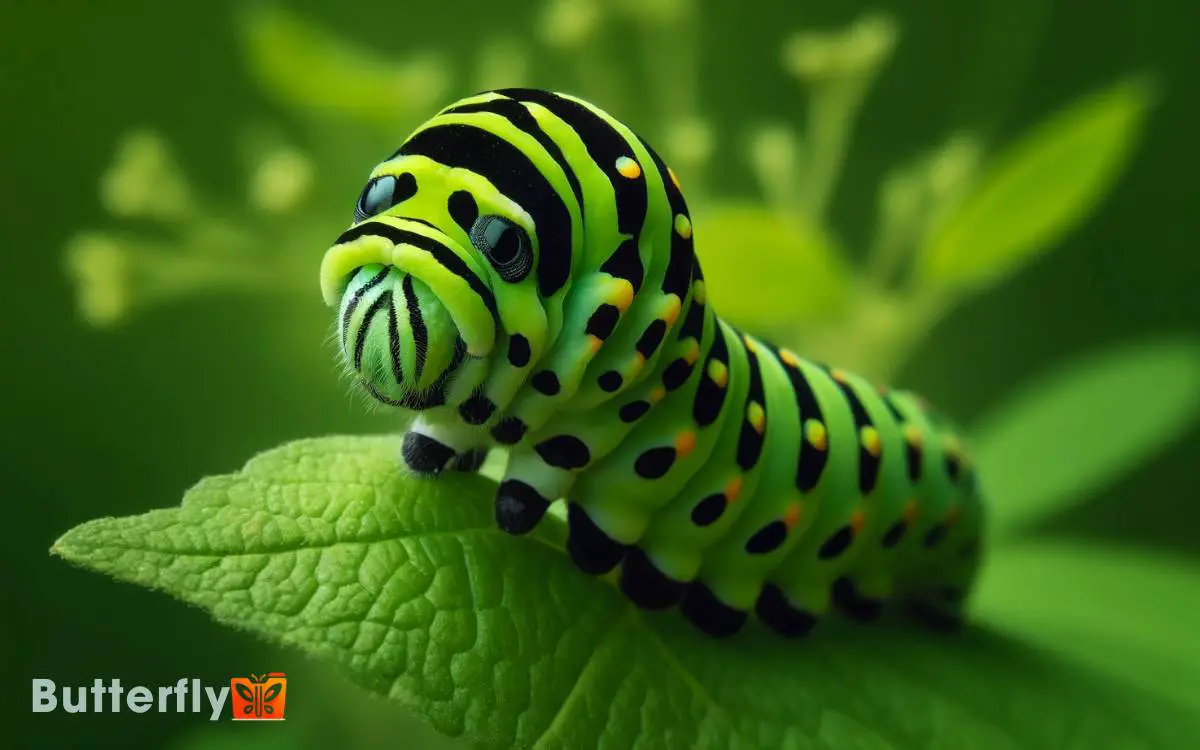Appalachian Tiger Swallowtail Butterfly Caterpillar: Explore
The Appalachian Tiger Swallowtail caterpillar (Papilio appalachiensis) is identifiable by its striking green body, yellow lateral lines, and distinct eye spots on its head.
These caterpillars favor host plants like tulip trees and black cherry, consuming large quantities of foliage for rapid growth. Their appearance mimics bird droppings in early stages, evolving to a snake-like look as a defense mechanism.Natural habitats include diverse forested areas with suitable microclimates. These adaptations guarantee their survival and contribute to ecosystem stability.
Learn more about their life cycles, symbiotic plant relationships, and conservation challenges to better understand their ecological role.

Key Takeaways
Identification and Appearance
The Appalachian Tiger Swallowtail butterfly caterpillar exhibits a distinctive green coloration with characteristic eye spots that mimic a snake’s eyes, providing an effective defense mechanism against predators.
This remarkable adaptation serves to deter birds and other potential threats.
The caterpillar’s body is robust, with a smooth texture and subtle yellow lateral lines running along its length. Its head is slightly enlarged, enhancing the illusion of a snake’s head. The eye spots are strategically positioned to create a convincing visual deterrent.
Additionally, the caterpillar’s green hue blends seamlessly with the foliage, offering camouflage in its natural environment. By combining these visual tricks, the Appalachian Tiger Swallowtail caterpillar secures its survival and progresses to the next stage of its lifecycle.
Natural Habitat
Blending seamlessly with the foliage, the Appalachian Tiger Swallowtail butterfly caterpillar thrives in the deciduous forests of the Appalachian region, where its green coloration and eye spots offer ideal protection against predators.
This habitat, characterized by its rich biodiversity and varied microclimates, provides the caterpillar with a plethora of resources essential for its survival and development.
The Appalachian deciduous forests are particularly suited to their life cycle due to:
- Diverse plant species: Offering both food and shelter.
- Microclimate variances: Ensuring favorable conditions for growth.
- Natural predators: Keeping population dynamics in check.
- Elevation gradients: Supporting various developmental stages.
- Seasonal changes: Synchronizing life cycles with environmental cues.
These factors collectively foster an environment where the caterpillar can flourish, ensuring the continuation of its species.
Diet and Feeding Habits
Frequently feeding on the leaves of host plants such as tulip trees, black cherry, and magnolias, the Appalachian Tiger Swallowtail butterfly caterpillar exhibits a voracious appetite essential for its rapid growth and development.
This species’ feeding behavior is characterized by continuous consumption of foliage, maximizing nutrient intake.
Utilizing specialized mandibles, it efficiently breaks down leaf tissue to access crucial nutrients. The caterpillar’s digestive system is adapted to process large quantities of plant material, converting it into energy and biomass.
Such dietary preferences guarantee a steady supply of food, crucial for its metamorphosis.
Life Cycle Stages
The life cycle of the Appalachian Tiger Swallowtail butterfly begins with the egg stage, where tiny eggs are laid on host plants.
Upon hatching, the larvae undergo multiple growth and molting phases, each stage characterized by specific physiological changes.
Egg to Larva
During this stage, the female Appalachian Tiger Swallowtail butterfly carefully selects a host plant.
She lays her eggs on the underside of leaves to protect them from predators and environmental stressors. These eggs are tiny, spherical, and pale green, blending seamlessly with the foliage.
The incubation period lasts about 4 to 10 days, depending on environmental conditions. Upon hatching, the larvae emerge as minuscule caterpillars, ready to commence their voracious feeding.
- Location: Eggs are laid on leaves of host plants like tulip trees and wild cherry.
- Appearance: Eggs are small, round, and green.
- Incubation: Lasts between 4 to 10 days.
- Emergence: Caterpillars are tiny and immediately begin to feed.
- Protection: Egg placement minimizes predation and environmental harm.
This stage is vital for their survival and growth.
Growth and Molting
As the tiny caterpillars commence their feeding, they rapidly enter the first of several growth stages, known as instars, where molting becomes a necessary process for their development.
Each instar represents a period of exponential growth, necessitating the shedding of the exoskeleton to accommodate their increasing size. Molting occurs multiple times, typically four to five, before the caterpillar reaches full larval maturity.
During each molt, the caterpillar’s body undergoes significant physiological changes, including the development of more intricate patterning and coloration. These adaptations serve both camouflage and warning functions, essential for survival.
Pupa to Butterfly
Upon reaching full larval maturity, the caterpillar enters the pupal stage, where it undergoes a remarkable metamorphosis within the protective casing of the chrysalis. This transformation is both intricate and crucial for the emergence of the adult butterfly.
During this stage, the caterpillar’s body breaks down into a nutrient-rich soup, which is then reorganized into the structures of an adult butterfly.
This process, known as histolysis and histogenesis, involves:
- Degeneration of larval tissues
- Formation of adult structures such as wings and antennae
- Reorganization of the digestive system
- Development of reproductive organs
- Hardening of the exoskeleton
The culmination of this metamorphosis is the emergence of the Appalachian Tiger Swallowtail butterfly, ready to begin its life as a free-flying adult.
Camouflage and Defense Mechanisms
The Appalachian Tiger Swallowtail butterfly caterpillar employs remarkable camouflage and defense mechanisms to evade predators and increase its chances of survival.
Initially, the caterpillar mimics bird droppings, blending seamlessly with its surroundings. This disguise deters birds and other predators.
As it grows, the caterpillar’s appearance transforms to resemble a small snake, complete with eye spots on its thorax.
These eye spots mimic the eyes of a snake, intimidating would-be predators. Additionally, the caterpillar can retract its head and inflate its thorax to enhance this illusion.
A chemical defense mechanism is also present; it secretes a foul-smelling substance when threatened, further deterring attacks. These adaptations collectively enhance the caterpillar’s survival in its natural habitat, ensuring it reaches the butterfly stage.
Role in the Ecosystem
Integral to the biodiversity of its habitat, the Appalachian Tiger Swallowtail butterfly caterpillar contributes to the ecosystem by serving as both a pollinator in its adult form and a food source for various predators during its larval stage.
This dual role supports ecological balance and nutrient cycling. Key contributions include:
- Pollination: Adult butterflies aid in the reproduction of flowering plants.
- Food Source: Caterpillars provide essential nourishment for birds, reptiles, and other insects.
- Nutrient Cycling: Decomposing caterpillars return nutrients to the soil.
- Biodiversity Support: Their presence encourages a diverse array of species.
- Ecosystem Resilience: They help maintain the stability and resilience of their habitats.
These roles underscore the caterpillar’s significance in sustaining ecological health and complexity.
Interaction With Other Species
The Appalachian Tiger Swallowtail butterfly caterpillar interacts with a variety of other species through complex ecological dynamics.
Predators such as birds and insects pose constant threats, prompting the caterpillar to develop sophisticated defensive mechanisms, including mimicry.
Additionally, its symbiotic relationships with host plants are vital, as these plants provide essential nutrients and habitat, while the caterpillar contributes to the plant’s pollination process.
Predators and Defenses
Predators pose a significant threat to Appalachian Tiger Swallowtail butterfly caterpillars, prompting these larvae to develop intricate defense mechanisms. To evade birds, spiders, and other predators, the caterpillars have evolved several sophisticated strategies.
They leverage mimicry, resembling bird droppings in early stages to avoid detection. Additionally, their later-stage green coloration blends seamlessly with foliage, providing camouflage.
They also exhibit a startling behavior, exposing an osmeterium, a forked gland that releases foul-smelling chemicals to deter attackers. Finally, their nocturnal feeding habits reduce exposure to diurnal predators.
- Mimicry resembling bird droppings in early stages
- Green coloration for effective camouflage
- Osmeterium releasing foul-smelling chemicals
- Nocturnal feeding habits
- Rapid growth to minimize vulnerable stages
These adaptations collectively enhance their survival in the wild.
Symbiotic Plant Relationships
Appalachian Tiger Swallowtail butterfly caterpillars primarily engage in mutualistic relationships with specific host plants, which provide essential nutrients and habitat for their growth and development.
These caterpillars mainly rely on plants such as tulip poplars and wild cherry trees.
The plants, in turn, benefit from the caterpillars by facilitating nutrient cycling through their waste. This interaction highlights a finely-tuned ecological balance, where the caterpillars gain sustenance and the plants experience growth advantages through natural fertilization.
The caterpillars’ dependence on these plants underscores the importance of preserving native flora to maintain this symbiotic relationship.
Understanding these intricate interactions empowers conservation efforts, ensuring both the caterpillars and their host plants can thrive in their natural habitats.
Seasonal Behavior
Emerging from their eggs in early spring, Appalachian Tiger Swallowtail butterfly caterpillars display distinct seasonal behaviors that secure their survival and development. At first, they mimic bird droppings to avoid predators, blending seamlessly into their surroundings. As they grow, their appearance shifts to resemble small snakes, an adaptation that further deters potential threats. One might wonder, do caterpillars know their future as they transform from these vulnerable larvae into magnificent butterflies, or do they simply follow nature’s predetermined path?
These caterpillars exhibit a series of adaptive strategies throughout their lifecycle, responding to environmental cues and changes in temperature.
- Feeding Patterns: They primarily feed during the warmer parts of the day to maximize nutrient intake.
- Shelter Seeking: Caterpillars seek shelter under leaves during cooler nights to maintain ideal body temperature.
- Growth Stages: The growth rate accelerates during the peak growing season, ensuring they mature before colder months.
- Molting Cycles: Molting frequently aligns with temperature fluctuations, facilitating rapid growth.
- Diapause: In late summer, they may enter a state of diapause to overwinter, resuming development when conditions improve.
Conservation Status
The Appalachian Tiger Swallowtail Butterfly Caterpillar faces significant conservation challenges, primarily due to habitat loss and environmental changes. Effective habitat preservation is critical to its survival, necessitating targeted conservation efforts.
These efforts must address both immediate threats and long-term sustainability to guarantee the species’ continued existence.
Habitat Preservation Needs
Effective habitat preservation is essential for maintaining the population of the Appalachian Tiger Swallowtail Butterfly Caterpillar due to its specific environmental requirements.
This species thrives in deciduous forests of the Appalachian region, requiring a precise balance of temperature, humidity, and host plants. Conservation efforts must focus on preserving these habitats to guarantee the survival of the caterpillar.
Key habitat preservation needs include:
- Forest integrity: Protecting large, contiguous tracts of deciduous forests.
- Host plant availability: Securing an abundant supply of Tulip trees and Black Cherry.
- Climate stability: Monitoring and mitigating climate change impacts.
- Pollution control: Reducing pesticide and herbicide use in these regions.
- Biodiversity promotion: Encouraging diverse plant and animal life to sustain ecosystem balance.
Threats and Challenges
Conservationists face significant hurdles in protecting the Appalachian Tiger Swallowtail Butterfly Caterpillar due to habitat fragmentation, climate change, and widespread pesticide use.
Rapid urban development has splintered their natural habitats, reducing the availability of essential host plants.
Climate change exacerbates the problem by altering temperature and precipitation patterns, which can disrupt the caterpillar’s development cycles and food sources.
Additionally, the pervasive use of pesticides in agriculture and residential areas poses a severe risk, as these chemicals can be fatal to both caterpillars and their adult butterfly forms.
Studies indicate that the cumulative impact of these threats results in declining population trends, raising concerns about the long-term viability of this species. Consequently, targeted conservation strategies are essential to mitigate these adverse effects.
Conservation Efforts Impact
Through concerted efforts in habitat restoration and the implementation of pesticide-free zones, conservation programs have begun to make measurable strides in stabilizing the population of the Appalachian Tiger Swallowtail Butterfly Caterpillar.
These initiatives focus on creating and maintaining environments that support the caterpillar’s lifecycle and reduce mortality rates.
Key strategies include:
- Habitat restoration: Rehabilitating forests and planting native flora.
- Pesticide regulation: Establishing pesticide-free zones to minimize chemical exposure.
- Public education: Raising awareness about the species and its ecological importance.
- Research funding: Supporting studies on the caterpillar’s behavior and habitat needs.
- Monitoring programs: Tracking population trends to assess the effectiveness of conservation efforts.
Collectively, these measures contribute to a more sustainable future for this unique butterfly species.
Interesting Facts
One fascinating fact about the Appalachian Tiger Swallowtail butterfly caterpillar is its remarkable ability to mimic bird droppings during its early stages to evade predators. This clever form of camouflage helps the caterpillar remain unnoticed by birds and other potential threats.
As it matures, the caterpillar undergoes a dramatic transformation in appearance, adopting bright green coloration with eye spots that resemble a snake’s head, further deterring predators.
Additionally, these caterpillars possess a unique osmeterium, a forked gland that emits foul-smelling chemicals when threatened. This defense mechanism, combined with their visual deception, provides a robust survival strategy.
Such intricate adaptations illustrate the complexity of evolutionary processes and highlight the caterpillar’s resilience in its natural habitat.
Conclusion
The Appalachian tiger swallowtail butterfly caterpillar’s distinctive appearance, natural habitat, and unique behaviors make it a fascinating subject of study.
For instance, researchers observed a caterpillar in the wild that used its remarkable camouflage to evade a predatory bird, showcasing its important defense mechanisms.
Understanding these traits is vital for conservation efforts. Protecting their habitats guarantees the survival of these intriguing creatures, highlighting the intricate balance within ecosystems.






